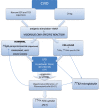A case report of lymphoid intestitial pneumonia in common variable immunodeficiency: Oligoclonal expansion of effector lymphocytes with preferential cytomegalovirus-specific immune response and lymphoproliferative disease promotion
- PMID: 28591035
- PMCID: PMC5466213
- DOI: 10.1097/MD.0000000000007031
A case report of lymphoid intestitial pneumonia in common variable immunodeficiency: Oligoclonal expansion of effector lymphocytes with preferential cytomegalovirus-specific immune response and lymphoproliferative disease promotion
Abstract
Rationale: Lymphoid interstitial pneumonia (LIP) is a rare disease with lymphocytic infiltration of the alveolar interstitial and air spaces, sometimes classified as a clonal lymphoproliferative disease (LPD) with high prevalence in patients with immunodysregulation. Although association of mucosa-associated lymphoid tissue (MALT) lymphoma development with infectious agents has been well described, it is not so in the case of LIP. Attempts to demonstrate an infective cause by direct microbe detection have failed, but association with atypical specific immune response to opportunistic infectious agent has not been studied.
Patient concerns and diagnoses: We performed clinical, biochemical, and immunologic analysis of patients LIP that arises primarily from the common variable immune deficiency (CVID) with normal immunoglobulin class M (IgM) level and mild infectious course as a result of immunodysregulation. At the age of 13 multiple nodules, areas of consolidation were observed and LIP was confirmed by histological examination. The progression of the disease with massive splenomegaly (17→27 cm), lymphadenopathy soft tissue infiltration coincides with high standardized uptake value (SUV was 3.1-5.2), regulatory T cells decrease (CD4+25FoxP3+ level -0.02%, i.e., 8 cells per 100 μL), oligoclonal gammapathy: very high IgM (3340 mg/dL) and β2-microglobulin (18.8 mg/L) level observed 10 years later.Immune response polarization was observed in humoral and cellular compartment -Th and Tc-dependent: 10.8% of lymphocytes are CD8high+CMV pp65-pentamer positive cells (Epstein-Barr virus-specific not observed). Specific immune response polarization correlates with negative immunofixation, light chains κ/λ = 2.84 and narrow, but non-monoclonal T cell receptor (TCR)/ B cell receptor (BCR) repertoire.
Lessons: Taking everything into account, this case report shows that LIP is a consequence of immune-dysregulation in CVID, that is, Treg deficiency, narrow lymphocyte repertoire, and abnormal ability to respond to cytomegalovirus (CMV) antigens. It may be visualized by positron emission tomography (PET) and monitored by CMV-specific immune response, β2-microglobulin level, and IgM paraproteinaemia, but not by immunofixation and κ/λ ratio.
Conflict of interest statement
The authors report no conflicts of interest.
Figures


Similar articles
-
Oligoclonal T cell expansions in pulmonary lymphoproliferative disorders: demonstration of the frequent occurrence of oligoclonal T cells in human immunodeficiency virus-related lymphoid interstitial pneumonia.Am J Respir Crit Care Med. 2002 Jan 15;165(2):254-9. doi: 10.1164/ajrccm.165.2.2101141. Am J Respir Crit Care Med. 2002. PMID: 11790664
-
Granulomatous lymphocytic interstitial lung disease in common variable immune deficiency: an in-depth clinical, immunological, functional and radiological exploration with a focus on its management, challenged by chronic CMV infection.Front Immunol. 2025 May 15;16:1589052. doi: 10.3389/fimmu.2025.1589052. eCollection 2025. Front Immunol. 2025. PMID: 40443662 Free PMC article.
-
Expansion of CD57+ CD8 T cells in common variable immunodeficiency with hepatopathy and CMV infection.Front Immunol. 2025 May 27;16:1577934. doi: 10.3389/fimmu.2025.1577934. eCollection 2025. Front Immunol. 2025. PMID: 40496855 Free PMC article.
-
Histology of Interstitial Lung Disease in Common Variable Immune Deficiency.Front Immunol. 2020 Nov 20;11:605187. doi: 10.3389/fimmu.2020.605187. eCollection 2020. Front Immunol. 2020. PMID: 33329602 Free PMC article. Review.
-
Granulomatous-lymphocytic interstitial lung disease (GLILD) in common variable immunodeficiency (CVID).Clin Immunol. 2010 Feb;134(2):97-103. doi: 10.1016/j.clim.2009.10.002. Epub 2009 Nov 8. Clin Immunol. 2010. PMID: 19900842 Review.
Cited by
-
High Monocyte Count Associated with Human Cytomegalovirus Replication In Vivo and Glucocorticoid Therapy May Be a Hallmark of Disease.Int J Mol Sci. 2022 Aug 24;23(17):9595. doi: 10.3390/ijms23179595. Int J Mol Sci. 2022. PMID: 36076989 Free PMC article.
-
CMV-Specific Immune Response-New Patients, New Insight: Central Role of Specific IgG during Infancy and Long-Lasting Immune Deficiency after Allogenic Stem Cell Transplantation.Int J Mol Sci. 2019 Jan 11;20(2):271. doi: 10.3390/ijms20020271. Int J Mol Sci. 2019. PMID: 30641912 Free PMC article.
-
Microbiome Analysis and Pharmacovigilance After Inhaled Glucocorticoid: Oral Dysbiosis With the Isolation of Three Rothia Species and Subsequent Sjögren's Syndrome.Front Pharmacol. 2022 Apr 1;13:636180. doi: 10.3389/fphar.2022.636180. eCollection 2022. Front Pharmacol. 2022. PMID: 35431920 Free PMC article.
-
Progressive Cachexia: Tuberculosis, Cancer, or Thyrotoxicosis? Disease-Directed Therapy and Atypical Courses of Autoimmune and Malignant Thyroid Diseases in a High Specialization Era: Case-Control Study with a Critical Literature Review.Biomedicines. 2024 Nov 28;12(12):2722. doi: 10.3390/biomedicines12122722. Biomedicines. 2024. PMID: 39767631 Free PMC article.
-
Lymphoid Interstitial Pneumonia in Common Variable Immune Deficiency - Case Report With Disease Monitoring in Various Therapeutic Options: Pleiotropic Effects of Rituximab Regimens.Front Pharmacol. 2019 Jan 18;9:1559. doi: 10.3389/fphar.2018.01559. eCollection 2018. Front Pharmacol. 2019. PMID: 30713498 Free PMC article.
References
-
- Arcadu A, Moua T, Yi ES, et al. Lymphoid interstitial pneumonia and other benign lymphoid disorders. Semin Respir Crit Care Med 2016;37:406–20. - PubMed
-
- Tokuyasu H, Watanabe E, Okazaki R, et al. Sjögren's syndrome with multiple bullae caused by lymphocytic interstitial pneumonia. Lung 2007;185:187–8. - PubMed
-
- Ishikawa CC, Ab'Saber AM, Parra ER, et al. Immunophenotyping and gene rearrangement analysis in lymphoid/lymphoproliferative disorders of the lungs. J Bras Pneumol 2007;33:625–34. - PubMed
Publication types
MeSH terms
Substances
Supplementary concepts
LinkOut - more resources
Full Text Sources
Other Literature Sources
Medical
Research Materials

